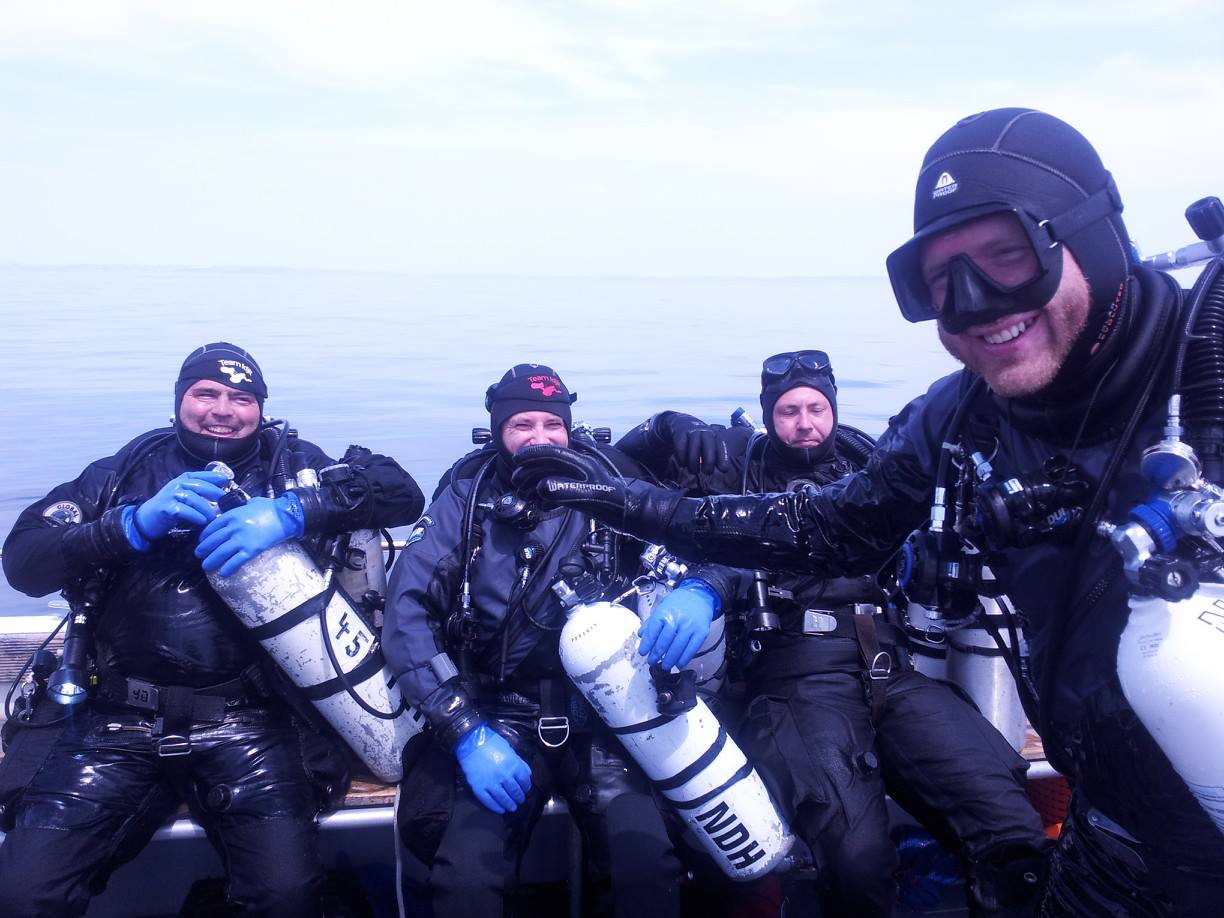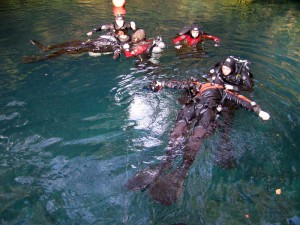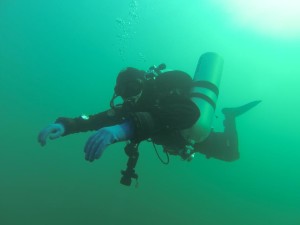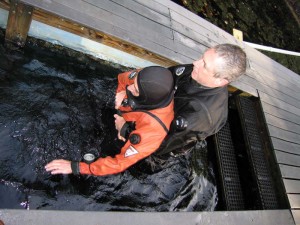News
Are you ready for TEK? – A guide to evaluating the Training, Equipment and Knowledge required for starting technical diving

Part 1 – Training
What was once out of reach to everyone but a select few is now part of the mainstream in many sports and diving is no exception. Caves and ocean depths that were until recently accessible only by experts with a lifetime of training can now be touched by those eager amateurs prepared to invest in training and equipment that is now widely available.
 However the increased availability of this specialised training and equipment presents us with a double edged sword. On one side are those who are prepared to make a long term investment and gain the right tools to safely enjoy diving in some incredible and extreme locations not accessible to 99% of the diving community. One the other side there are divers seeking short cut training modelled on mainstream recreational courses. This often results in inadequate training, equipment and experience that can cause them to end up in situations and locations that they will realise they are ill prepared for far too late.
However the increased availability of this specialised training and equipment presents us with a double edged sword. On one side are those who are prepared to make a long term investment and gain the right tools to safely enjoy diving in some incredible and extreme locations not accessible to 99% of the diving community. One the other side there are divers seeking short cut training modelled on mainstream recreational courses. This often results in inadequate training, equipment and experience that can cause them to end up in situations and locations that they will realise they are ill prepared for far too late.
So in a series of three articles I wanted to explore the three key areas of training, equipment and knowledge (TEK) that a diver should carefully consider before starting a progression down this route.
How do you get the Training?
#1 – Do your research. Who is doing the diving you want to do and how did they get trained?
 I made a number of early decisions at the start of my technical diving career based on two areas of information. I read voraciously about the sorts of diving I wanted to do. Tales of North East US deep wrecks and North Florida caves in the 80’s & 90’s led me to leading lights of those scenes and then I looked at how they gained their experience and training. Fortunately by the time I started down this route in 2008 things were a little more organised than the early days of deep wreck and cave diving! Today you can easily research the divers, agencies and instructors and find out if, what and how they are doing things appeals to you. There are huge online resources to get your grey matter going, however be aware of polarised ‘internet opinions’ as they will hold you back.
I made a number of early decisions at the start of my technical diving career based on two areas of information. I read voraciously about the sorts of diving I wanted to do. Tales of North East US deep wrecks and North Florida caves in the 80’s & 90’s led me to leading lights of those scenes and then I looked at how they gained their experience and training. Fortunately by the time I started down this route in 2008 things were a little more organised than the early days of deep wreck and cave diving! Today you can easily research the divers, agencies and instructors and find out if, what and how they are doing things appeals to you. There are huge online resources to get your grey matter going, however be aware of polarised ‘internet opinions’ as they will hold you back.
#2 – Get your basic dive skills nailed. You need to be solid before building complex skills.
 Finding a baseline of where you are today is vital before considering developing complex new skills. You may think your basic skills such as trim, buoyancy control and propulsion are pretty good (everyone’s is right?) but the reality is they probably fall short of the entry point of many technical or cave classes. During training you will be expected to remain in a flat (trim) static position in mid water (not kneeling!) and this can prove difficult even for experienced divers. A technical diver will be able to maintain trim within a 15 degree window, buoyancy with a 1m window even when task loaded such as performing a gas switch, sharing gas or manipulating a valve. Have you ever wondered why the visibility behind you is so bad? So you will also need a range of kicks designed to not disturb silt and be able to manoeuvre in a confined space. The fact is none of these basic dive skills are naturally occurring and you really need an experienced technical diver who is also an instructor to give you structured feedback and develop your basic skills. You should consider a foundational course from an agency with an established technical curriculum such as GUE fundamentals before moving on.
Finding a baseline of where you are today is vital before considering developing complex new skills. You may think your basic skills such as trim, buoyancy control and propulsion are pretty good (everyone’s is right?) but the reality is they probably fall short of the entry point of many technical or cave classes. During training you will be expected to remain in a flat (trim) static position in mid water (not kneeling!) and this can prove difficult even for experienced divers. A technical diver will be able to maintain trim within a 15 degree window, buoyancy with a 1m window even when task loaded such as performing a gas switch, sharing gas or manipulating a valve. Have you ever wondered why the visibility behind you is so bad? So you will also need a range of kicks designed to not disturb silt and be able to manoeuvre in a confined space. The fact is none of these basic dive skills are naturally occurring and you really need an experienced technical diver who is also an instructor to give you structured feedback and develop your basic skills. You should consider a foundational course from an agency with an established technical curriculum such as GUE fundamentals before moving on.
#3 – Be prepared to pay and be prepared to not pass. If you see a ‘cheap’ technical class with a 100% pass rate, run.
 The sorts of class you are looking at are probably quite a bit more money and longer than your basic dive classes. For example most ‘normoxic’ trimix and basic cave classes are between 5-6 days and there will be a gas bill at the end of it! You may even have to travel and pay for boat costs. It can quickly add up and add to personal pressure to ‘perform’.
The sorts of class you are looking at are probably quite a bit more money and longer than your basic dive classes. For example most ‘normoxic’ trimix and basic cave classes are between 5-6 days and there will be a gas bill at the end of it! You may even have to travel and pay for boat costs. It can quickly add up and add to personal pressure to ‘perform’.
Your instructor will also fully understand the environment they are teaching you to dive in and will not accept second best. This means no matter how much you have spent they simply will not pass you if you don’t make the grade.
#4 – Make sure your instructor is an active diver. You want real experience, not training slates.
 I have already mentioned the cost of training at this level. You are for the most part paying for that instructor’s experience as much you are paying for their time. A good instructor should be diving above the level that they are teaching, so they will be bringing a huge amount of personal diving experience to your class. Many instructors only teach and this brings nothing to this type of diving. The best instructors I know work hard to maintain a balance between being active divers and educators.
I have already mentioned the cost of training at this level. You are for the most part paying for that instructor’s experience as much you are paying for their time. A good instructor should be diving above the level that they are teaching, so they will be bringing a huge amount of personal diving experience to your class. Many instructors only teach and this brings nothing to this type of diving. The best instructors I know work hard to maintain a balance between being active divers and educators.
In the next part of this series I will be looking at the equipment required for technical and cave training. Are you prepared to change your entire configuration right down to your fins?
James teaches exclusively as a GUE (Global Underwater Explorers) instructor for TecLife (www.divelife.co.uk).
Gear News
Introducing the TR-80, IR-50 and CS-30 Regulators from DYNAMICNORD

Whether you are a beginner or a professional diver – with the three new main regulators from DYNAMICNORD, everyone will find their favourite regulator. They all look super stylish.
Excellent performance with the TR-80
Quality and performance are the be-all and end-all for regulators. It is not for nothing that the TR stands for Tec Reg. The innovative design of the TR-80 guarantees absolute reliability – even in ice-cold waters.

Perfect breathing effort at 0.8 J/l / certified for diving in waters below 10 degrees / structural design made of solid brass for best cold protection / membrane-compensated design with dry seal of the first stage / reduced exhalation effort thanks to optimized exhalation membrane and bubble deflector / adjustable Venturi (dive/predive) and adjustment knob for individual inhalation comfort / innovative design of the front cover prevents free-flow in strong currents or when diving with scooters / design made of sandblasted brass, matt chrome finish / 2 HP and 4 LP outlets / mouthpiece made of high-quality, anti-allergic silicone for maximum comfort.


Amazing underwater adventures with the IR-50
The IR-50 is the top regulator for advanced and experienced divers. Natural breathing is the essence of this regulator.

Ideal breathing effort at 0.8 J/l /certified for diving in waters below 10 degrees / compensated membrane / adjustable venturi (dive/predive) and adjustment knob for individual inhalation comfort/ outlet valve and deflector for minimum exhalation effort and reduction of bubbles on the face / design made of sandblasted brass, matt chrome finish / 2 HP and 4 NP outlets / mouthpiece made of high-quality, anti-allergic silicone for maximum comfort.


The Workhorse – our CS-30
For diving centres and diving beginners – the workhorse stands for strong construction, reliability and robustness. Perfect for your training.

Optimal breathing effort at 0.8 J/l /recommended for diving in waters above 10 degrees / non-compensated piston / adjustable venturi (dive/predive) / outlet valve and deflector for minimum exhalation effort and reduction of bubbles on the face / design made of sandblasted brass, matt chrome finish / 1 HP and 3 NP outlets / mouthpiece made of high-quality, anti-allergic silicone for maximum comfort.


Octopus OP-30
The OP-30 is the ideal addition to all DYNAMICNORD regulators. It is identical in construction to the CS-30.

The TR-80, IR-50, CS-30 (DIN & INT) regulators and the Octopus OP-30 are available from DYNAMICNORD dealers and in the online store.
DYNAMICNORD – Your Outdoor Companion.
Marine Life & Conservation
Paul Watson Released as Denmark Blocks Japan’s Extradition Bid

Renowned anti-whaling activist Paul Watson has been released from custody in Greenland after spending five months in detention. Denmark’s Justice Ministry rejected Japan’s request for his extradition, citing insufficient guarantees that his time already served in custody would be credited against any potential sentence.
The 74-year-old Canadian-American was arrested on July 21 in Nuuk, Greenland’s capital, when his ship docked to refuel. His arrest was based on a 2012 Japanese warrant related to a 2010 encounter in Antarctic waters. Japan alleged Watson obstructed operations and caused damage to a whaling research ship during efforts to disrupt illegal whaling. Watson has consistently denied these claims, maintaining his commitment to marine conservation.
Denmark, which oversees extradition matters for Greenland, concluded that while the legal conditions for extradition were met, the lack of assurances from Japan regarding time-served credit made extradition untenable.
In a video shared by his foundation, Watson expressed gratitude and relief, saying, “After five months, it’s good to be out… and good to know they’re not sending me to Japan.” He added that the most difficult part of his time in custody was being separated from his two young sons.
Watson is a pioneering figure in marine conservation, known for founding the Captain Paul Watson Foundation in 2022 after decades of activism with the Sea Shepherd Conservation Society. His bold efforts to defend marine life have earned him widespread support, including from celebrities and conservationists. His work has also been featured in the acclaimed reality TV series Whale Wars.
Watson’s lawyer, Jonas Christoffersen, praised the decision, stating, “We are happy and relieved that Paul Watson is now free.” He added that Watson is eager to reunite with his family and continue his vital work.
The arrest occurred while Watson’s vessel, the M/Y John Paul DeJoria, was en route to the North Pacific with a team of 26 volunteers to intercept a Japanese whaling ship. His foundation described the arrest as politically motivated and emphasized that Watson’s actions were focused on ending illegal whaling practices.
Japan resumed commercial whaling in 2019 after leaving the International Whaling Commission, asserting that whale meat is a cultural tradition. Conservationists, however, continue to challenge these practices, highlighting their impact on marine ecosystems.
Despite the challenges, Watson remains steadfast in his mission to protect marine life and bring attention to whaling practices. His dedication to ocean conservation has made him a globally respected advocate for the environment.
-

 News2 months ago
News2 months agoIconic SS United States to become the World’s Largest Artificial Reef
-

 News3 months ago
News3 months agoBook Review – 52 Assignments: Underwater Photography
-

 Gear News3 months ago
Gear News3 months agoDYNAMICNORD – New German diving brand enters the British market
-

 News3 months ago
News3 months agoExploring Cenote El Pit: A Diver’s Dream
-

 Gear News3 months ago
Gear News3 months agoTry BARE drysuits (and maybe even win one!) this Friday with Sea & Sea at North West Dive Fest
-

 Marine Life & Conservation3 months ago
Marine Life & Conservation3 months agoBook Review: Coral Triangle Cameos
-

 Blogs2 months ago
Blogs2 months agoDive the Egyptian Red Sea this Autumn with Regaldive
-

 News3 months ago
News3 months ago2024 Ocean Art Underwater Photo Competition Announced















